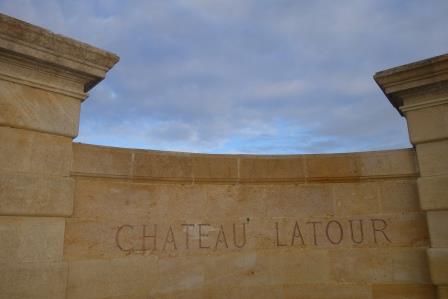2005 Château Latour Grand Vin Pauillac Bordeaux France Wine Tasting Note
50380 Views
|
Powerful, tannic, bold, firm and structured, this is perhaps the quintessential example of the fist inside the iron glove. This is incredibly powerful, focused and precise. It's also quite structured, dense and tannic. 13,122 Views Tasted May 29, 2017With a depth of color that still looks young, with coaxing you find, tobacco, cigar box, cedar chest, forest floor, smoke and caramel notes in the nose, but it takes effort to find everything at 10 years of age. The wine is powerful, tannic, full bodied, young and mouth filling. The wine offers concentration, intensity, length and refined textures, but if I gave the impression it’s ready to drink, it’s not. It’s more serious than fun to taste today, so give it time and air. From a blend of 87% Cabernet Sauvignon, 12% Merlot and 1% Cabernet Franc, the wine reached 13.5% ABV and was produced from just 44% of the harvest. 14,660 Views Tasted Jun 28, 2015Better than when tasted, this stunner, produced from a blend of 87% Cabernet Sauvignon, 12% Merlot and 1% Petit Verdot serves up a nose packed with earth, smoke, blackberry and espresso bean. The wine is powerful, dense, refined and youthful. It really packs a mouthful of flavor and intensity in every sip. 10,425 Views Tasted Jan 7, 2015This really coats your mouth with flavor. Layer after layer of sweet, fat, ripe, juicy fruits, plush, soft tannins, licorice and silk seem like they never leave your palate. This is intensity paired with purity, concentration and complexity at its best. In a few years, OK, more than a few, perhaps a decade or two, this should really hit its stride. The wine really leaves a lasting impression. From a blend of 87% Cabernet Sauvignon, 12% Merlot, and 1% Petit Verdot, only 44% of the harvest was placed into the Grand Vin. FWIW, this was tasted blind. Note to self, remain friends with people who have this elixir in their cellar as I really want to taste this when both, the wine I, are mature. Comments not needed on which will mature first. 12,173 Views Tasted Feb 13, 2014 |

When to Drink Chateau Latour, Anticipated Maturity, Decanting Time
Chateau Latour is not a wine to drink on the young side. The wine is usually far too tannic, powerful and reserved during its youth. Young vintages can be decanted for an average of 3-6 hours, give or take. This allows the wine to soften and open its perfume. Older vintages might need very little decanting, just enough to remove the sediment.
Chateau Latour is usually better with at least 15 years of bottle age. Of course, that can vary slightly, depending on the vintage character. Chateau Latour offers its best drinking and should reach peak maturity between 18 and 60 years of age after the vintage.
Serving Chateau Latour with Wine and Food Pairings
Chateau Latour is best served at 15.5 degrees Celsius, 60 degrees Fahrenheit. The cool, almost cellar temperature gives the wine more freshness and lift.
Chateau Latour is best paired with all types of classic meat dishes, veal, pork, beef, lamb, duck, game, roast chicken, roasted, braised and grilled dishes. Chateau Latour is also good when matched with Asian dishes, rich fish courses like tuna, mushrooms and pasta.
In 2011, Chateau Latour added to their holdings in Pauillac when they purchased the 4-hectare vineyard of Chateau La Becasse from the Fonteneau family. The vines are used for the production of Forts de Latour.
Chateau Latour became one of the first major Bordeaux chateaus to embrace anti-counterfeiting measures with the use of the Prooftag system which is in place on the label, bottle and capsule of all future and current releases.
In 2015, Chateau Latour completed renovations which included new offices, tasting rooms and cellars. In fact, Chateau Latour became the first estate in the Medoc to maintain a cellar solely devoted to keeping magnums and other large-format bottling's dating back to 1900. The new cellars were a necessity as they allowed Latour to retain vast stocks of wines, for later releases.
The Pinault family also own other wineries through their holding company the Artemis Group. In Burgundy, they own Domaine d’Eugenie, previously known as Domaine Rene Engel. The vines are located in the Vosne Romanee appellation in the Cote de Nuits. Late 2017, marked another addition to their holdings in Burgundy when they purchased Clos de Tart for a record-setting price of more than 30 Million Euros per hectare!
In the Northern Rhone Valley, they own Chateau Grillet, which prior to their recent sale had been owned by the same family since 1830!
In July 2013, the family added to their list of vineyards with the purchase of Araujo Estate wines, in the Napa Valley. Araujo has since been renamed Eisele Vineyards. The following year, in 2014, The Artemis Group made their first purchase in the Right Bank, when they invested in Chateau Vray Croix de Gay, Pomerol, Chateau Siaurac, which is located in the Lalande de Pomerol appellation and Chateau Le Prieure in St. Emilion. They sold all their Right Bank vineyards, September 2020 to Suravenir Insurance, the owner of Chateau Calon Segur.

